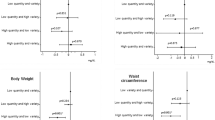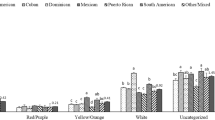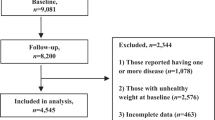Abstract
Background/Objectives:
We aimed to investigate the associations of colors of fruit and vegetable (FV) subgroups, with 3-year changes of cardiometabolic risk factors.
Subjects/Methods:
This longitudinal study was conducted in the framework of Tehran Lipid and Glucose Study, between 2006–2008 and 2009–2011, on 1272 adults. Total intake of FV and their subgroups have been assessed by a validated semi-quantitative food frequency questionnaire at baseline (2006–2008) and again at the second examination (2009–2011). Demographics, anthropometrics and biochemical measures were evaluated at baseline and 3 years later. The associations of anthropometric and lipid profile changes with FV subgroups were estimated.
Results:
The mean age of men and women at baseline was 39.8±12.7 and 37.3±12.1 years, respectively. Mean total intake of FV, red/purple, yellow, green, orange and white FV was 706±337, 185±95, 141±91, 152±77, 141±87 and 22±18 g/day, respectively. In men, 3-year changes of weight (β=−0.13, P=0.01) and waist circumference (β=−0.14, P=0.01) were related to intake of red/purple FV; the yellow group was inversely associated with 3-year changes of total cholesterol (β=−0.09, P=0.03) and High-density lipoprotein cholesterol (β=−0.11, P=0.03). Consumption of green and white FV was inversely related to abdominal fat gain, and atherogenic lipid parameters in men (P<0.05). In women, higher intake of red/purple FV was associated to lower weight and abdominal fat gain, fasting serum glucose and total cholesterol (P<0.05); yellow FV was also related to 3-year weight gain (β=−0.11, P=0.01).
Conclusions:
Various colors of FV subgroups had different effects on cardiometabolic risk factors; higher intake of red/purple FV may be related to lower weight and abdominal fat gain, and yellow, green and white FV may be related to lipid parameters.
This is a preview of subscription content, access via your institution
Access options
Subscribe to this journal
Receive 12 print issues and online access
$259.00 per year
only $21.58 per issue
Buy this article
- Purchase on Springer Link
- Instant access to full article PDF
Prices may be subject to local taxes which are calculated during checkout
Similar content being viewed by others
References
Hung HC, Joshipura KJ, Jiang R, Hu FB, Hunter D, Smith-Warner SA et al. Fruit and vegetable intake and risk of major chronic disease. J Natl Cancer Inst 2004; 96: 1577–1584.
Joshipura KJ, Hu FB, Manson JE, Stampfer MJ, Rimm EB, Speizer FE et al. The effect of fruit and vegetable intake on risk for coronary heart disease. Ann Intern Med 2001; 134: 1106–1114.
Dauchet L, Amouyel P, Hercberg S, Dallongeville J . Fruit and vegetable consumption and risk of coronary heart disease: a meta-analysis of cohort studies. J Nutr 2006; 136: 2588–2593.
Zern TL, Fernandez ML . Cardioprotective effects of dietary polyphenols. J Nutr 2005; 135: 2291–2294.
Pennington JAT, Fisher RA . Classification of fruits and vegetables. J Food Compost Anal 2009; 22: S23–S31.
Pennington JAT, Fisher RA . Food component profiles for fruit and vegetable subgroups. J Food Compost Anal 2010; 23: 411–418.
Oude Griep LM, Verschuren WM, Kromhout D, Ocke MC, Geleijnse JM . Colors of fruit and vegetables and 10-year incidence of stroke. Stroke 2011; 42: 3190–3195.
Oude Griep LM, Verschuren WM, Kromhout D, Ocke MC, Geleijnse JM . Colours of fruit and vegetables and 10-year incidence of CHD. Br J Nutr 2011; 106: 1562–1569.
Oude Griep LM, Verschuren WM, Kromhout D, Ocke MC, Geleijnse JM . Variety in fruit and vegetable consumption and 10-year incidence of CHD and stroke. Public Health Nutr 2012; 15: 2280–2286.
Azizi F, Rahmani M, Emami H, Mirmiran P, Hajipour R, Madjid M et al. Cardiovascular risk factors in an Iranian urban population: Tehran lipid and glucose study (phase 1). Soz Praventivmed 2002; 47: 408–426.
Hosseini-Esfahani F, Jessri M, Mirmiran P, Bastan S, Azizi F . Adherence to dietary recommendations and risk of metabolic syndrome: Tehran Lipid and Glucose Study. Metabolism 2010; 59: 1833–1842.
Willett W, Stampfer MJ . Total energy intake: implications for epidemiologic analyses. Am J Epidemiol 1986; 124: 17–27.
He K, Hu FB, Colditz GA, Manson JE, Willett WC, Liu S . Changes in intake of fruits and vegetables in relation to risk of obesity and weight gain among middle-aged women. Int J Obes Relat Metab Disord 2004; 28: 1569–1574.
Vioque J, Weinbrenner T, Castello A, Asensio L, Garcia de la Hera M . Intake of fruits and vegetables in relation to 10-year weight gain among Spanish adults. Obesity (Silver Spring) 2008; 16: 664–670.
Mozaffarian D, Hao T, Rimm EB, Willett WC, Hu FB . Changes in diet and lifestyle and long-term weight gain in women and men. N Engl J Med 2011; 364: 2392–2404.
Aljadani HM, Patterson A, Sibbritt D, Hutchesson MJ, Jensen ME, Collins CE . Diet quality, measured by fruit and vegetable intake, predicts weight change in young women. J Obes 2013; 2013: 525161.
Drapeau V, Despres JP, Bouchard C, Allard L, Fournier G, Leblanc C et al. Modifications in food-group consumption are related to long-term body-weight changes. Am J Clin Nutr 2004; 80: 29–37.
Sanchez-Villegas A, Bes-Rastrollo M, Martinez-Gonzalez MA, Serra-Majem L . Adherence to a Mediterranean dietary pattern and weight gain in a follow-up study: the SUN cohort. Int J Obes (Lond) 2006; 30: 350–358.
Vergnaud AC, Norat T, Romaguera D, Mouw T, May AM, Romieu I et al. Fruit and vegetable consumption and prospective weight change in participants of the European Prospective Investigation into Cancer and Nutrition-Physical Activity, Nutrition, Alcohol, Cessation of Smoking, Eating Out of Home, and Obesity study. Am J Clin Nutr 2012; 95: 184–193.
Buijsse B, Feskens EJ, Schulze MB, Forouhi NG, Wareham NJ, Sharp S et al. Fruit and vegetable intakes and subsequent changes in body weight in European populations: results from the project on Diet, Obesity, and Genes (DiOGenes). Am J Clin Nutr 2009; 90: 202–209.
Halkjaer J, Tjonneland A, Overvad K, Sorensen TI . Dietary predictors of 5-year changes in waist circumference. J Am Diet Assoc 2009; 109: 1356–1366.
Nooyens AC, Visscher TL, Schuit AJ, van Rossum CT, Verschuren WM, van Mechelen W et al. Effects of retirement on lifestyle in relation to changes in weight and waist circumference in Dutch men: a prospective study. Public Health Nutr 2005; 8: 1266–1274.
Halkjaer J, Sorensen TI, Tjonneland A, Togo P, Holst C, Heitmann BL . Food and drinking patterns as predictors of 6-year BMI-adjusted changes in waist circumference. Br J Nutr 2004; 92: 735–748.
Djousse L, Arnett DK, Coon H, Province MA, Moore LL, Ellison RC . Fruit and vegetable consumption and LDL cholesterol: the National Heart, Lung, and Blood Institute Family Heart Study. Am J Clin Nutr 2004; 79: 213–217.
Radhika G, Sudha V, Mohan Sathya R, Ganesan A, Mohan V . Association of fruit and vegetable intake with cardiovascular risk factors in urban south Indians. Br J Nutr 2008; 99: 398–405.
Mirmiran P, Noori N, Zavareh MB, Azizi F . Fruit and vegetable consumption and risk factors for cardiovascular disease. Metabolism 2009; 58: 460–468.
Nakamura K, Nagata C, Oba S, Takatsuka N, Shimizu H . Fruit and vegetable intake and mortality from cardiovascular disease are inversely associated in Japanese women but not in men. J Nutr 2008; 138: 1129–1134.
Hoffman R, Gerber M . Evaluating and adapting the Mediterranean diet for non-Mediterranean populations: a critical appraisal. Nutr Rev 2013; 71: 573–584.
Du H, van der AD, Boshuizen HC, Forouhi NG, Wareham NJ, Halkjaer J et al. Dietary fiber and subsequent changes in body weight and waist circumference in European men and women. Am J Clin Nutr 2010; 91: 329–336.
Liu RH . Health benefits of fruit and vegetables are from additive and synergistic combinations of phytochemicals. Am J Clin Nutr 2003; 78: 517S–520S.
Acknowledgements
We thank the TLGS participants and the field investigators of the TLGS for their assistance in physical examinations, biochemical and nutritional evaluation and database management. We acknowledge Ms. Niloofar Shiva for critical editing of English grammar and style of the manuscript. This study was supported by grant 121 from National Research Council of the Islamic Republic of Iran and the Research Institute for Endocrine Sciences of Shahid Beheshti University of Medical Sciences.
Author Contributions
The project was designed and implemented by ZB and PM. Data were analyzed and interpreted by ZB and SB. ZB, NM and PM prepared the manuscript. PM and FA supervised overall project. All authors read and approved the final version of manuscript.
Author information
Authors and Affiliations
Corresponding author
Ethics declarations
Competing interests
The authors declare no conflict of interest.
Rights and permissions
About this article
Cite this article
Mirmiran, P., Bahadoran, Z., Moslehi, N. et al. Colors of fruits and vegetables and 3-year changes of cardiometabolic risk factors in adults: Tehran lipid and glucose study. Eur J Clin Nutr 69, 1215–1219 (2015). https://doi.org/10.1038/ejcn.2015.49
Received:
Revised:
Accepted:
Published:
Issue Date:
DOI: https://doi.org/10.1038/ejcn.2015.49
This article is cited by
-
Association of fruit and vegetable color with incident diabetes and cardiometabolic risk biomarkers in the United States Hispanic/Latino population
Nutrition & Diabetes (2022)
-
Fruit and vegetable consumption, cardiovascular disease, and all-cause mortality in China
Science China Life Sciences (2022)
-
One-year changes in fruit and vegetable variety intake and cardiometabolic risk factors changes in a middle-aged Mediterranean population at high cardiovascular risk
European Journal of Clinical Nutrition (2022)



